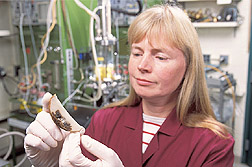This page has been archived and is being provided for reference purposes only. The page is no longer being updated, and therefore, links on the page may be invalid.
|
Read the magazine story to find out more. |
Friendly Bacteria Help Fight Potato Rot FungiBy Jan SuszkiwJune 12, 2002 Soil-dwelling bacteria are scientists’ latest weapon against an unsightly post-harvest disease called dry rot that costs U.S. potato growers as much as $250 million annually in tuber losses. Agricultural Research Service scientists Patricia Slininger, David Schisler and colleagues are testing the bacteria as a biological alternative to thiabendazole (TBZ), a chemical fungicide that’s losing its effectiveness against Fusarium sambucinum, the main culprit behind dry rot. Through ARS, its in-house research agency, the U.S. Department of Agriculture holds two patents on the bacteria as biological dry rot control agents. A third patent covers their use to inhibit sprouting, another costly potato storage problem. The two scientists began exploring the bacteria’s biocontrol potential in 1994, when a third ARS researcher--Ann Desjardens--reported TBZ resistance in 90 percent of dry rot strains she isolated from potato fields. At ARS’ National Center for Agricultural Utilization Research in Peoria, Ill., Slininger and Schisler researched different physical and nutritional conditions for mass-producing the bacteria in liquid culture and keeping them viable during cold storage. Lab tests and trial runs in potato storage houses indicate that spraying tubers with the bacteria can diminish dry rot disease by 59 percent or more. The six Pseudomonas and Enterobacter strains being tested are harmless to humans, but form a living bandage around potato wound sites that stymies dry rot infections. The bacteria secrete natural antibiotics that suppress the dry rot fungus. One such antibiotic, indoleacetic acid, may also help retard sprouting on stored potatoes. Cultures of some of the biocontrol bacteria seem to retard stored potato sprouting nearly as well as 1-methylethyl-3-chlorophenylcarbamate (CIPC). Although used on more than half the U.S. potato crop, CIPC faces tighter regulation due to concerns over its persistence in the environment and on the spuds. Now that the patents are available for licensing, the Peoria scientists are seeking a commercial partner to adapt the technology for market use. A longer story about their work appears in the June issue of Agricultural Research magazine. |

